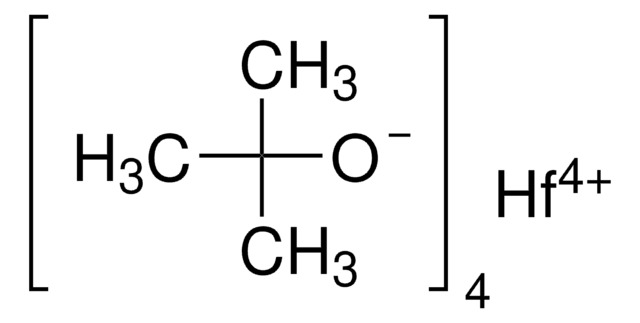590592
Hafnium(IV) chloride
purified by sublimation, 99.9% trace metals basis
Synonym(s):
Hafnium tetrachloride, Tetrachlorohafnium
Sign Into View Organizational & Contract Pricing
All Photos(1)
About This Item
Linear Formula:
HfCl4
CAS Number:
Molecular Weight:
320.30
EC Number:
MDL number:
UNSPSC Code:
12352302
PubChem Substance ID:
NACRES:
NA.23
Recommended Products
vapor pressure
1 mmHg ( 190 °C)
Quality Level
Assay
99.9% trace metals basis
form
powder
purified by
sublimation
impurities
≤1500.0 ppm Trace Metal Analysis
SMILES string
Cl[Hf](Cl)(Cl)Cl
InChI
1S/4ClH.Hf/h4*1H;/q;;;;+4/p-4
InChI key
PDPJQWYGJJBYLF-UHFFFAOYSA-J
Looking for similar products? Visit Product Comparison Guide
Application
Hafnium(IV) chloride can be used as a catalyst:
- To synthesize α-aminophosphonates via the one-pot three-component reaction of aldehyde, amine, and phosphite.
- For the conversion of carbohydrates into 5-hydroxymethylfurfural in ionic liquids.
- For parallel synthesis of 1,2-disubstituted benzimidazoles from N-substituted phenylenediamines and aldehydes.
- A precursor to prepare hafnium oxide nanoparticles via sol-gel method.
- A starting material to synthesize bulky guanidinato hafnium(iv) chloridecomplexes.
accessory
Product No.
Description
Pricing
Signal Word
Danger
Hazard Statements
Precautionary Statements
Hazard Classifications
Eye Dam. 1 - Met. Corr. 1 - Skin Corr. 1B
Supplementary Hazards
Storage Class Code
8B - Non-combustible corrosive hazardous materials
WGK
WGK 3
Flash Point(F)
Not applicable
Flash Point(C)
Not applicable
Choose from one of the most recent versions:
Already Own This Product?
Find documentation for the products that you have recently purchased in the Document Library.
Customers Also Viewed
Visualization of the cytoskeletal elements in tissue culture cells by bloc-staining with hafnium chloride after rapid freezing and freeze-substitution fixation.
T Hatae et al.
Journal of electron microscopy, 33(2), 186-190 (1984-01-01)
Guoguang Liu et al.
Biomacromolecules, 9(3), 949-953 (2008-02-15)
The feasibility of a previously established method based on ozonolysis and hydrogenation reactions for the production of 9-hydroxynonanoic acid from oleic acid has been demonstrated. Metal catalyzed lactonization conditions have been used to convert 9-hydroxynonanoic acid into 1,11-dioxacycloicosane-2,12-dione, which is
Lutz Ackermann et al.
Organic & biomolecular chemistry, 5(12), 1975-1978 (2007-06-07)
Two distinct economical catalysts for intramolecular hydroaminations of electronically unactivated alkenes with basic amines are described, which are based on (a) group 4 metal halides under basic reaction conditions or (b) Brønsted-acid organocatalysts.
Our team of scientists has experience in all areas of research including Life Science, Material Science, Chemical Synthesis, Chromatography, Analytical and many others.
Contact Technical Service







